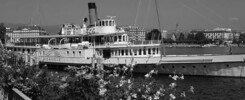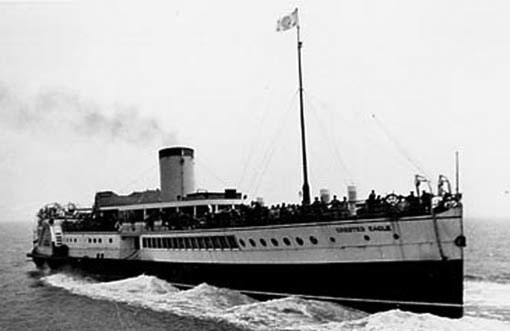
I mentioned in my last selection (Part 1 here) that we very seldom went on a GSN ship but my favourite was the magnificent Crested Eagle. Compared with the Queen Line ships she was much more spacious as well as having a great turn of speed. At this time we lived at Westcliff a mile or so along the front from Southend in a flat looking out across the Estuary and I used to watch her racing along, particularly on the return from Clacton trying to catch up time en route back to London. She was the only steamer in the Estuary that you could hear the wonderful beat of her paddle wheels a mile or so away.
In E C B Thornton’s book “South Coast Pleasure Steamers” he states “she had a race with Brighton Queen back to Brighton after the 1937 Spithead Review.” Much to his regret she beat Brighton Queen to the pier, as he, Thornton, was a passenger on the looser. To my mind she would have beaten all those South Coast steamers famous for their speed. A marvellous build by Whites of Cowes in 1923 and very sad that she was lost at Dunkirk.
I always liked to watch the various Masters and observe how they handled their ships coming alongside Southend Pier. Capt. Sargent of the Crested Eagle was always number one in my book. He also always looked so smart and kid gloves were worn whatever the weather.
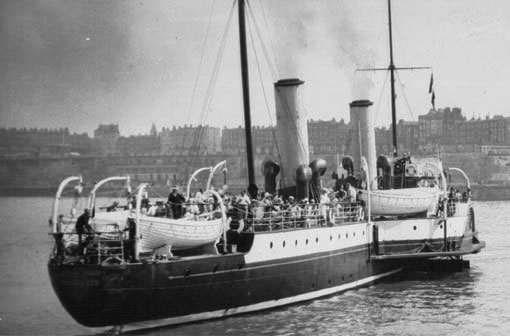
Queen of Thanet was originally built as an Ascot Class Minesweeper in World War I, (HMS Melton) and bought by Capt Shippick of the New Medway Steam packet Company in 1927 together with her sister Queen of Kent (ex HMS Athelstone). Both were sold to Red Funnel in 1948. I include this steamer because on it my sister took me on my first paddle steamer trip across the Channel to Calais in 1938. It was on an August Bank Holiday cheap day excursion via Margate and the weather was perfect and the ship was packed to capacity. My sister did not enjoy it at all as there were long queues for everything and very little space for sitting on the open deck. I happily stood by the rail or wandered around the ship and watched the engines. I just thought how wonderful it was to paddle that distance.
Queen of Thanet was also the first steamer back in the Thames after the World War II, so I was fortunate to paddle down the Thames in her from Tower Pier to Southend on the first trip of the season in 1946. It was on this day that I first met Don Rose (later of Queen of the South ex Jeanie Deans fame) and it was from him that I heard it was possible to make a very long trip on a P&A Campbell paddle steamer from Bristol to Brighton or visa versa at the beginning and end of the season.
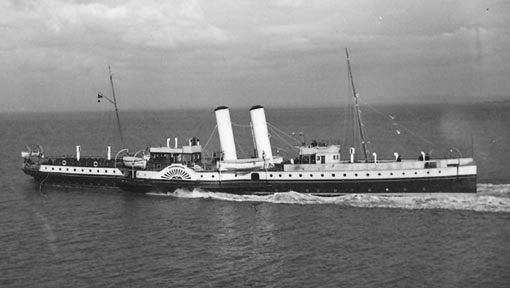
It was on the Glen Gower in 1950 that I made my first round voyage from Bristol to Brighton that Don Rose had told me about. We boarded at Bristol first thing in the morning calling en route at Cardiff & Ilfracombe. After a wonderful run along the Devon & Cornish coasts we rounded Lands End and the following morning were making our way along the South Coast arriving at Brighton later that afternoon – a 33 hour trip. I made another long trip in 1953 when the Glen Gower sailed to Brighton to assist in the Spithead Review of that year. I also remember her trips from Eastbourne to Boulogne and in 1956 I made the last sailing in her across the Channel. She did not return to the South Coast after that but remained in service in the Bristol Channel and was laid up in 1958.
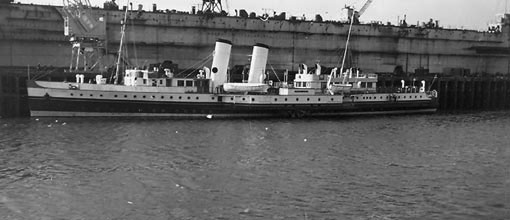
Cardiff Queen was one of the two ships built after the War for P & A Campbell. For some reason I don’t think she was as popular in the Bristol Channel as Bristol Queen nevertheless I found out that she was a very good sea ship. I joined her at Brighton in late September 1953 for what should have been the usual end of season run back to Bristol. We left in quite good weather but after passing the Needles a strong SW wind sprang up and off Portland the weather began to turn very nasty. It soon became force 8 gale. The ship was pitching heavily and we were taking a lot of water across the bow and this continued until it was dark. When approaching Plymouth the Master told us that he intended to berth there until the weather abated, but warned us that when turning to go into Plymouth we should expect heavy rolling as the sea and wind would be on our beam. This proved very true and several of us thought our last hour had come. Eventually we made Plymouth and stayed the night in the dock. Next day we set of again along the coast but the weather was very bad and when near to Lands End in very heavy seas the Captain turned the ship and headed for Falmouth for another overnight stay.
Next day the weather had not improved and the Company decided we should make our own way home from Falmouth. The Cardiff Queen did not manage to get back to Bristol for another three days so it was a sensible decision but a dramatic voyage I remember to this day very vividly.
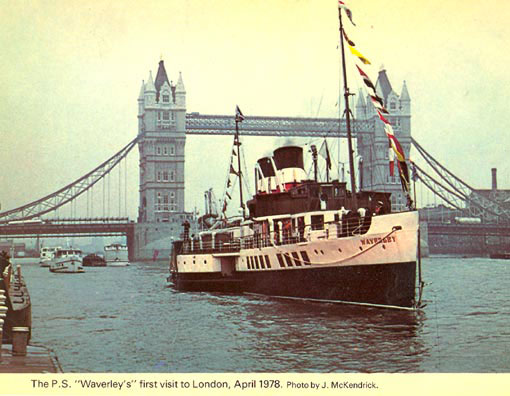
Forty years on and now that I am an oldie, I find it amazing that I have again been able to cross the Channel in a paddle steamer, Waverley. My first was to Calais and later on a cruise near to the beaches of Dunkirk where a small ceremony was held and a wreath dropped into the sea in memory of all those ships and men who perished in 1940. It was a very moving occasion. How lucky we are in 2006 still to be able to enjoy so many places round the coasts of Great Britain in Waverley.
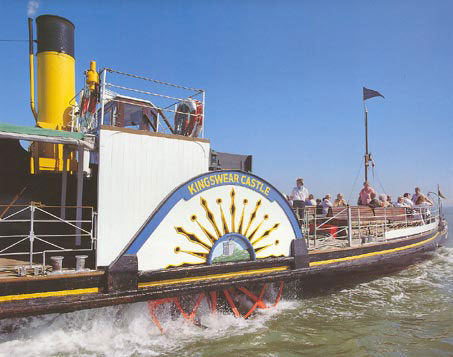
I would like to finish my selection with our smaller paddle steamer Kingswear Castle, the main subject of this website. She was built for service on the river Dart in Devon in 1924, has been beautifully restored and still has her coal fired steam engine and is kept in pristine condition by her Master and Crew. We in the South East are so lucky to be the only area in the UK which has a paddle steamer sailing throughout each summer season and, when Waverley visits us, we have two. When Medway Queen finished in 1963 we could never have expected that two paddle steamers plus the historic motor ship Balmoral, would still be operating in the Thames and Medway area in 2006.
Kingswear Castle returned to service in 2023 after the first part of a major rebuild which is designed to set her up for the next 25 years running on the River Dart. The Paddle Steamer Kingswear Castle Trust is now fund raising for the second phase of the rebuild. You can read more about the rebuilds and how you can help if you can here.
John Megoran


